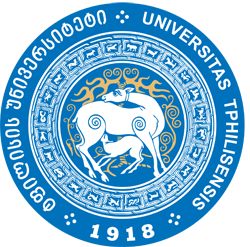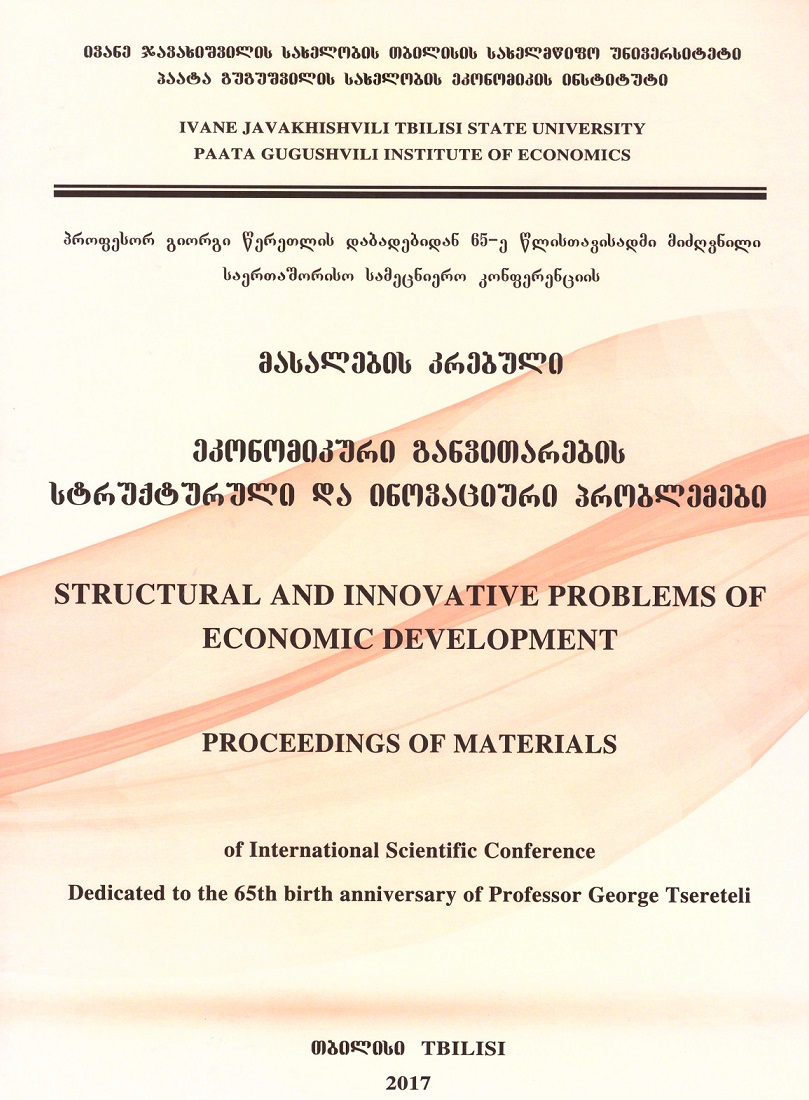
Ivane Javakhishvili Tbilisi State University
Paata Gugushvili Institute of Economics International Scientific

FROM ECONOMIC CRISES TO SOCIAL STRAIN: UNDERSTANDING DEMOGRAPHIC CHANGE IN GEORGIA
Annotation: Economic threats in Georgia have significant social and demographic consequences. Historical and contemporary shocks - including the 2008 global financial crisis, the COVID-19 pandemic, and regional instability - have exacerbated unemployment, income inequality, and migration pressures. These dynamics contribute to social tensions and demographic challenges, including urban-rural disparities, youth emigration, declining fertility, and population aging. This article examines the complex interaction between economic vulnerabilities, social tensions, and demographic trends in Georgia, highlighting structural imbalances and proposing integrated policy measures to foster social cohesion, sustainable development, and demographic resilience.
Keywords: economic threats, social tension, demographic change, migration, urban-rural disparity
Introduction
Since gaining independence in 1991, Georgia has undergone profound socio-economic and political transformation, punctuated by arduous challenges and significant transitions. The collapse of the Soviet Union precipitated severe economic decline, social instability, and regional conflicts over disputed territories such as Abkhazia and South Ossetia, leading to the displacement of tens of thousands of people. These crises compromised political stability and delayed the establishment of effective market institutions, constraining the government's capacity to manage economic reforms and respond adequately to internal and external shocks [World Bank, 2018], [Geostat, 2023].
In recent decades, Georgia has progressively integrated into global markets, catalyzing growth in services, tourism, and information technology sectors. However, economic growth has been uneven and accompanied by persistent vulnerabilities. The economy’s dependence on energy imports, a low-productivity agricultural sector bound by fragmented landholdings, and disparities between urban and rural regions have compounded socio-economic challenges [World Bank, 2021][Stiglitz, 2012]. These factors have intersected with demographic pressures, including declining fertility rates, accelerated population aging, and substantial youth emigration, thereby exacerbating social tensions and threatening long-term stability [Eurostat, 2020], [Castles, 2010].
This article examines the multifaceted dynamics linking economic crises, social strains, and demographic changes in Georgia. Drawing upon verified statistical data and scholarly analyses, it elucidates how economic vulnerabilities spur social inequalities and demographic transformations that disproportionately affect rural communities, marginalized ethnic groups, and youth. Moreover, the study advocates for integrated policy approaches designed to foster economic resilience, social cohesion, and demographic sustainability, thereby securing Georgia’s path to inclusive and sustainable development.
Economic Threats and Their Consequences
Georgia’s economy exhibits structural weaknesses that increase its susceptibility to both domestic and external shocks. Energy dependence is a critical vulnerability, as Georgia imports the majority of its electricity and fossil fuels, leaving the economy sensitive to global price fluctuations [Geostat, 2023:12].
Agriculture remains a key employer, engaging roughly 40% of the workforce, but contributes only 10% of GDP due to low productivity, fragmented landholdings, and outdated technology [World Bank, 2021:34]. The service sector dominates GDP (72%) but employs only 42% of the workforce, creating a mismatch that contributes to structural unemployment, particularly among youth and women. Remittances account for 8–9% of GDP and provide essential household support, yet they also expose Georgia to external economic volatility [World Bank, 2021:33].
Table 1 Sectoral Contribution to GDP and Employment Structure
|
Sector |
GDP Contribution (%) |
Workforce Employment (%) |
|
Agriculture |
10 |
40 |
|
Industry |
18 |
18 |
|
Services |
72 |
42 |
Source: Geostat, 2023
Structural imbalances drive high unemployment and limited social mobility, particularly in rural regions. Western areas such as Samegrelo-Zemo Svaneti lag behind urban centers like Tbilisi and Batumi, leading to rural-to-urban migration and pressure on urban infrastructure [World Bank, 2018:27], [Geostat, 2023:17]. Poverty remains concentrated in peripheral regions, such as Racha-Lechkhumi (28%), whereas urban residents enjoy comparatively higher living standards [Geostat, 2023:17].
Historical crises illustrate Georgia’s economic fragility. The 2008 global financial crisis led to a 6.2% GDP contraction, sharply rising unemployment, and disproportionate effects on rural populations [World Bank, 2021:34]. The COVID-19 pandemic severely impacted the tourism and services sectors, resulting in income loss for informal workers and further exacerbating rural-urban disparities [World Bank, 2020:9]. More recently, the 2022 regional instability due to the Ukraine conflict triggered inflation, energy price surges, and emigration pressures [Stiglitz, 2012:88].
Table 2 Rural and Urban Unemployment Rates in Georgia, 2010–2023
|
Year |
Rural Unemployment (%) |
Urban Unemployment (%) |
|
2010 |
22 |
11 |
|
2015 |
25 |
13 |
|
2020 |
24 |
12 |
|
2023 |
23 |
12 |
Source: Geostat, 2023
Social Tensions
Economic disparities and structural weaknesses have been key drivers of social tensions in Georgia. The unequal distribution of wealth and access to opportunities between urban and rural areas creates persistent grievances. Rural-to-urban migration intensifies competition for housing, healthcare, education, and employment in cities like Tbilisi, Batumi, and Kutaisi. Urban infrastructure often struggles to accommodate this influx, resulting in overcrowded schools, strained healthcare facilities, and rising housing costs [Geostat, 2023:18].
Ethnic and regional inequalities further compound social tensions. Minority groups, including Azeris, Armenians, Abkhazians, and Ossetians, often reside in marginalized areas with limited economic and educational opportunities. These communities frequently face structural barriers to participation in the formal labor market, reinforcing perceptions of exclusion and social inequity [Sen, 1999:78]. Marginalization can also manifest in political disenfranchisement, as communities with fewer resources and lower education levels have reduced access to decision-making processes at local and national levels.
Youth unemployment, particularly acute in certain regions where it can exceed 30%, drives both domestic and international migration. Young people often leave rural areas in search of better educational and employment prospects, which not only diminishes human capital in their communities but also fosters frustration and political disengagement. High unemployment among youth and women in rural areas can also heighten vulnerability to informal or precarious work, increasing economic insecurity and social instability [Castles, 2010:44], [World Bank, 2020:9].
Social tensions are also visible in public demonstrations and protests. Historically, socio-economic grievances have sparked demonstrations over issues such as wage delays, inadequate social services, and corruption. These protests illustrate the direct link between economic pressure and social unrest and underscore how perceptions of government responsiveness - or lack thereof - affect public trust. Citizens in disadvantaged regions often feel that the state prioritizes urban centers over rural communities, which can reinforce distrust in institutions and exacerbate tensions between different regions of the country.
Urban-rural disparities are further reinforced by unequal access to technology and digital infrastructure. While urban populations increasingly benefit from high-speed internet, digital services, and online education, rural communities lag behind, limiting economic opportunities, educational attainment, and participation in civic life. This digital divide exacerbates the socio-economic gap, further fueling social tensions and potentially limiting rural development.
The COVID-19 pandemic highlighted these social inequalities starkly. While urban centers adapted more quickly to remote work and online education, rural communities experienced service disruptions, job losses in agriculture and informal sectors, and limited healthcare access. These inequalities created heightened stress within households and communities, particularly among low-income populations, elderly residents, and single-parent families [World Bank, 2020:9].
In addition, internal displacement due to conflicts in Abkhazia and South Ossetia has contributed to social tensions. Internally displaced persons (IDPs), numbering over 250,000, often live in temporary or underdeveloped settlements, facing challenges in securing stable employment, education, and housing. Their integration into host communities can create competition over limited resources, occasionally triggering friction between displaced and local populations [UN, 2019:56].
Overall, social tensions in Georgia are multifaceted, rooted in structural economic inequalities, regional disparities, ethnic marginalization, youth unemployment, and demographic pressures. Addressing these tensions requires comprehensive social policies that improve access to education, healthcare, and employment opportunities across all regions, foster inclusion of marginalized communities, and strengthen public trust in governance. Only by mitigating the structural sources of inequality can Georgia promote long-term social cohesion and stability.
Table 3 Urban and Rural Population Distribution in Georgia
|
Area |
Population (%) |
|
Urban |
57 |
|
Rural |
43 |
Source: Geostat, 2023
Demographic Trends
Georgia faces pressing demographic challenges driven by declining fertility, population aging, and high emigration rates, which collectively threaten long-term socio-economic stability. Fertility has steadily declined from 2.2 births per woman in 2000 to 1.7 in 2023, falling below the replacement level of 2.1 [Geostat, 2023:19], [World Bank, 2023]. Factors contributing to this decline include urbanization, delayed marriage, economic uncertainty, and limited support for working families. Young couples increasingly postpone childbearing due to financial insecurity, housing constraints, and career considerations, particularly in urban centers like Tbilisi and Batumi.
Population aging is becoming a significant demographic pressure. The proportion of individuals aged 65 and older has risen from 9% in 2000 to 14% in 2023 [Eurostat, 2020:22]. This trend places growing strain on healthcare systems, pensions, and social services. An aging population also reduces the working-age labor force, which can constrain economic growth, limit productivity, and heighten dependency ratios. Rural areas are particularly affected, as younger generations migrate to urban centers or abroad, leaving behind an older population that requires increasing care and support.
Youth emigration is another critical concern, creating both immediate and long-term challenges for economic development. Skilled and educated young people often leave the country in search of better employment opportunities, higher wages, and improved quality of life, leading to a “brain drain” that disproportionately impacts rural areas. The loss of human capital undermines the potential for local innovation, entrepreneurship, and economic diversification, further entrenching regional disparities [Castles, 2010:95], [BM.VGTU, 2023]. Remittances from emigrants partially mitigate household-level economic stress but do not compensate for the loss of skilled labor or address the demographic imbalance.
Gender disparities in labor participation further shape demographic outcomes. Female employment in rural areas remains lower than in urban centers, limiting household income, reducing fertility incentives, and reinforcing intergenerational poverty cycles. Policies that support female workforce participation, such as childcare provision, flexible working arrangements, and vocational training, are essential for mitigating these effects and fostering demographic stability [World Bank, 2018; BM.VGTU, 2022].
Urbanization trends also influence demographic dynamics. As of 2023, 57% of Georgia’s population resides in urban areas [Geostat, 2023:18]. While urban living provides greater access to education, healthcare, and employment, it also encourages smaller family sizes due to housing costs, career demands, and lifestyle preferences. Conversely, rural regions experience both population decline and aging, creating localized demographic imbalances that affect economic development and social cohesion.
The interplay between declining fertility, population aging, and emigration results in rising dependency ratios, increasing the burden on working-age individuals to support the elderly and young dependents. This dynamic has significant implications for public finances, healthcare systems, and pension sustainability. Without targeted interventions, Georgia faces the risk of a shrinking workforce, lower economic productivity, and greater socio-economic inequality.
Table 4 Fertility Rate and Share of Population Aged 65+ in Georgia, 2000–2023
|
Year |
Fertility Rate |
% Population 65+ |
|
2000 |
2.2 |
9 |
|
2010 |
2.0 |
11 |
|
2020 |
1.8 |
13 |
|
2023 |
1.7 |
14 |
Source: Geostat, 2023; Eurostat, 2020
Addressing these demographic challenges requires a multi-pronged approach. Policies to support family formation, such as childcare services, parental leave, affordable housing, and flexible work arrangements, can help stabilize fertility rates. Incentivizing the return of skilled emigrants through employment opportunities, professional networks, and competitive wages can counteract brain drain. Regional development initiatives can balance population distribution, ensuring rural areas remain viable and socially cohesive. Additionally, integrating demographic considerations into economic planning, healthcare provision, and social policy is essential to ensure that Georgia’s population structure supports long-term sustainable development.
Ultimately, demographic trends in Georgia are not isolated phenomena but are deeply intertwined with economic vulnerabilities and social dynamics. Declining fertility, aging, and emigration both shape and are shaped by economic insecurity, social inequalities, and regional disparities. Addressing these trends is therefore critical not only for population stability but also for broader socio-economic resilience and sustainable development.
Policy Recommendations
Addressing Georgia’s intertwined economic, social, and demographic challenges requires a multi-dimensional, integrated approach. Policies must simultaneously tackle structural economic weaknesses, social inequalities, and demographic pressures to ensure sustainable development and social cohesion. The following recommendations offer a roadmap for achieving these goals:
- Economic Diversification and Resilience
- Invest in Strategic Sectors: Prioritize development of renewable energy, ICT, advanced manufacturing, and modernized agriculture to reduce dependence on remittances, fossil fuels, and external shocks [Stiglitz, 2012:45].
- Support Small and Medium-Sized Enterprises (SMEs): Encourage entrepreneurship and innovation through tax incentives, simplified regulations, and access to affordable credit to generate employment, particularly for youth and women [World Bank, 2021:34].
- Modernize Agriculture: Promote mechanization, irrigation, and cooperative farming to improve productivity and reduce rural poverty [World Bank, 2021:34].
- Regional Economic Development: Target investment in lagging regions like Samegrelo-Zemo Svaneti and Racha-Lechkhumi to reduce disparities and curb migration pressures [World Bank, 2018].
- Enhancing Social Cohesion
- Expand Access to Education and Vocational Training: Tailor programs to rural and marginalized communities to reduce youth unemployment [Geostat, 2023:18].
- Improve Healthcare Access: Strengthen rural healthcare infrastructure and provide mobile health services [World Bank, 2020].
- Support Vulnerable Populations: Assist internally displaced persons, ethnic minorities, and low-income households to reduce exclusion and social tension [UN, 2019:56].
- Promote Civic Engagement: Foster inclusive governance to build public trust [World Bank, 2018].
- Demographic Strategies
- Family Support Policies: Implement childcare, parental leave, housing subsidies, and flexible work arrangements [Geostat, 2023].
- Return Migration Programs: Provide incentives for skilled emigrants to return for knowledge transfer [BM.VGTU, 2023].
- Regional Population Balance: Invest to make rural areas attractive for settlement and employment [World Bank, 2018].
- Gender Inclusion: Promote female labor participation through vocational training and gender-sensitive policies [BM.VGTU, 2022].
- Strengthening International Cooperation
- Collaborate with EU, World Bank for technical and financial support [World Bank, 2021:34].
- Facilitate knowledge and technology transfer for governance and social policy best practices.
- Integrated Policy Implementation
- Cross-Sector Coordination: Establish inter-ministerial task forces for coherent policy design and delivery [World Bank, 2018].
- Develop data systems to assess policy effectiveness.
- Engage citizens in policy awareness to enhance participation and trust.
Table 5 Policy Measures and Expected Outcomes
for Sustainable Socio-Economic Development
|
Policy Area |
Measures |
Expected Outcomes |
|
Economic Diversification |
Renewable energy, SMEs, modern agriculture |
Reduced vulnerability, job creation, regional growth |
|
Social Cohesion |
Education, healthcare, minority support, civic engagement |
Reduced inequality, improved trust, social stability |
|
Demographic Strategy |
Family support, return migration, regional development, gender inclusion |
Balanced migration, increased fertility, empowered workforce |
|
International Support |
EU/UNDP/World Bank cooperation, funding |
Enhanced resilience, adoption of best practices |
|
Integrated Implementation |
Coordination, monitoring, public engagement |
Efficient policy delivery, evidence-based outcomes |
Conclusion
Georgia’s socio-economic landscape reveals a complex interplay of economic fragility, social strain, and demographic evolution that holds profound implications for the country’s future wellbeing. The nation remains vulnerable to external shocks due to structural economic weaknesses such as reliance on remittances, limited industrial diversification, and underperforming agriculture - issues that contribute to uneven regional development and persistent rural poverty [World Bank, 2018], [Geostat, 2023].
These economic imbalances manifest socially as disparities in employment opportunities, restricted access to essential services, and ethnic marginalization, fueling social tensions that threaten political stability and social harmony. Young people, particularly from rural areas, face high unemployment and limited prospects, prompting significant migration flows that drain the country’s human capital and exacerbate demographic imbalances [Castles, 2010], [BM.VGTU, 2023].
Demographically, Georgia’s declining fertility and an aging population present additional challenges by shrinking the labor force and increasing the dependency burden, thereby straining public finances and social service systems [Eurostat, 2020], [Geostat, 2023]. These trends, intertwined with regional disparities and migration patterns, necessitate comprehensive policy responses.
Proactive measures integrating economic diversification, social inclusion, and demographic support are vital to mitigate vulnerabilities and harness development opportunities. Strengthened international partnerships, especially with multilateral institutions, can amplify these efforts by providing crucial technical and financial assistance [World Bank, 2021], [UN, 2019].
Ultimately, Georgia’s long-term stability and prosperity depend on coordinated policy frameworks that address the interlinked dimensions of economic, social, and demographic change. By promoting equitable growth, fostering social cohesion, and enhancing demographic resilience, Georgia can build a sustainable future that benefits all its citizens.
References
- BM.VGTU, 2023. Emigration Statistics – The Herald of the Survival of the Population of Georgia or the Demographic Crisis. Vilnius Gediminas Technical University.
- BM.VGTU, 2022. Gender Imbalances in the Georgian Labor Market and Peculiarities of the Impact of the COVID-19 Pandemic. Vilnius Gediminas Technical University.
- Castles S., 2010. Migration and Social Tensions. Oxford University Press, pp. 44, 95.
- Eurostat, 2020. Demographic Trends in Europe. Brussels: European Commission, p. 22.
- Geostat, 2023. Annual Economic Indicators. Tbilisi: National Statistics Office of Georgia, pp. 12, 17–19.
- Sen A., 1999. Development as Freedom. Oxford University Press, p. 78.
- Stiglitz J., 2012. The Price of Inequality. W.W. Norton & Company, pp. 45, 88.
- United Nations, 2019. World Urbanization Prospects. New York: United Nations, p. 56.
- World Bank, 2018. South Caucasus in Motion: Economic and Social Mobility in Armenia, Azerbaijan, and Georgia. Washington D.C.: World Bank.
- World Bank, 2020. The Early Labor Market Impacts of COVID-19 in Developing Countries: Evidence from High-Frequency Phone Surveys.
- World Bank, 2021. Global Economic Prospects. Washington D.C.: World Bank, pp. 12, 33–34.
- World Bank, 2023. World Development Indicators Database.
